Presentation: Newman's Theory of Health & Critical Evaluation
VerifiedAdded on 2022/08/25
|20
|2380
|60
Presentation
AI Summary
This presentation provides a detailed analysis of Margaret Newman's theory of health as expanding consciousness, exploring its structural and functional components, assumptions, and applications within nursing practice, particularly in cardiac and oncology settings. It includes a critique of two articles related to the theory, evaluating their clarity, consistency, and usefulness in practice, research, education, and administration. The presentation also examines the influence of the theorist versus the theory and assesses the external components, such as personal values and social significance, as reflected in the selected articles. The analysis offers a comparative perspective, highlighting the strengths and weaknesses of each article in relation to Newman's theory and its practical implications. Desklib offers more resources for students.
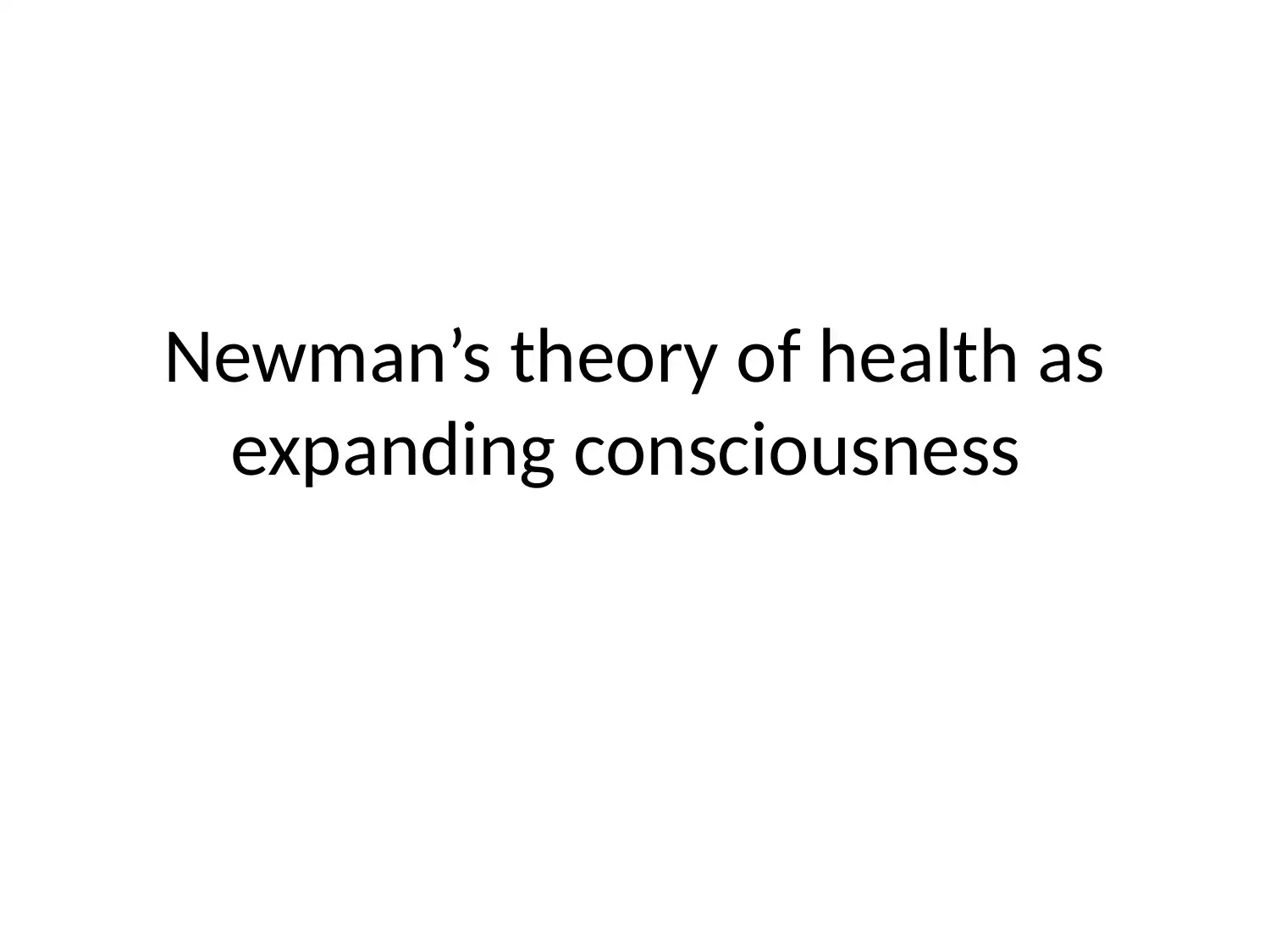
Newman’s theory of health as
expanding consciousness
expanding consciousness
Paraphrase This Document
Need a fresh take? Get an instant paraphrase of this document with our AI Paraphraser
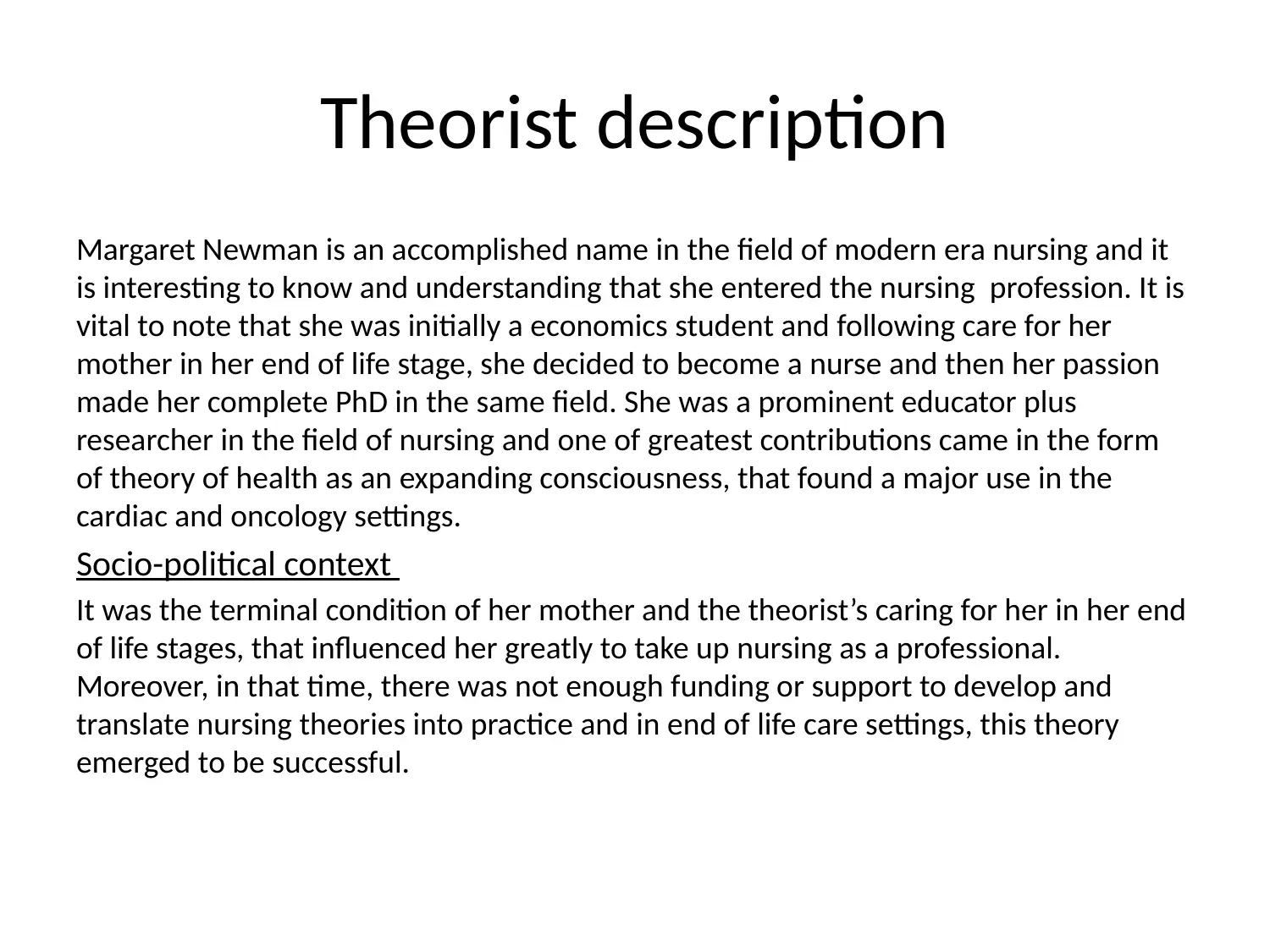
Theorist description
Margaret Newman is an accomplished name in the field of modern era nursing and it
is interesting to know and understanding that she entered the nursing profession. It is
vital to note that she was initially a economics student and following care for her
mother in her end of life stage, she decided to become a nurse and then her passion
made her complete PhD in the same field. She was a prominent educator plus
researcher in the field of nursing and one of greatest contributions came in the form
of theory of health as an expanding consciousness, that found a major use in the
cardiac and oncology settings.
Socio-political context
It was the terminal condition of her mother and the theorist’s caring for her in her end
of life stages, that influenced her greatly to take up nursing as a professional.
Moreover, in that time, there was not enough funding or support to develop and
translate nursing theories into practice and in end of life care settings, this theory
emerged to be successful.
Margaret Newman is an accomplished name in the field of modern era nursing and it
is interesting to know and understanding that she entered the nursing profession. It is
vital to note that she was initially a economics student and following care for her
mother in her end of life stage, she decided to become a nurse and then her passion
made her complete PhD in the same field. She was a prominent educator plus
researcher in the field of nursing and one of greatest contributions came in the form
of theory of health as an expanding consciousness, that found a major use in the
cardiac and oncology settings.
Socio-political context
It was the terminal condition of her mother and the theorist’s caring for her in her end
of life stages, that influenced her greatly to take up nursing as a professional.
Moreover, in that time, there was not enough funding or support to develop and
translate nursing theories into practice and in end of life care settings, this theory
emerged to be successful.
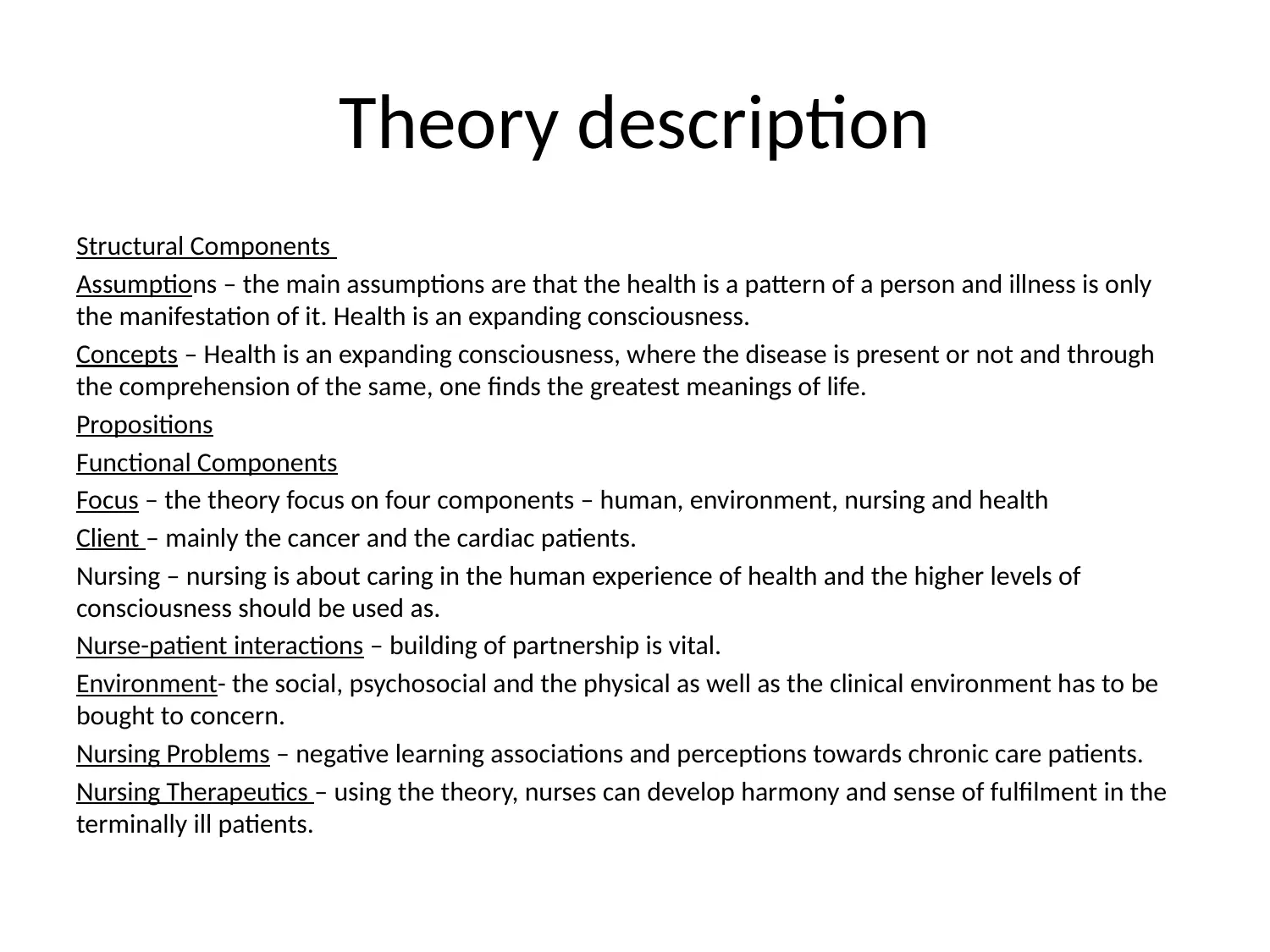
Theory description
Structural Components
Assumptions – the main assumptions are that the health is a pattern of a person and illness is only
the manifestation of it. Health is an expanding consciousness.
Concepts – Health is an expanding consciousness, where the disease is present or not and through
the comprehension of the same, one finds the greatest meanings of life.
Propositions
Functional Components
Focus – the theory focus on four components – human, environment, nursing and health
Client – mainly the cancer and the cardiac patients.
Nursing – nursing is about caring in the human experience of health and the higher levels of
consciousness should be used as.
Nurse-patient interactions – building of partnership is vital.
Environment- the social, psychosocial and the physical as well as the clinical environment has to be
bought to concern.
Nursing Problems – negative learning associations and perceptions towards chronic care patients.
Nursing Therapeutics – using the theory, nurses can develop harmony and sense of fulfilment in the
terminally ill patients.
Structural Components
Assumptions – the main assumptions are that the health is a pattern of a person and illness is only
the manifestation of it. Health is an expanding consciousness.
Concepts – Health is an expanding consciousness, where the disease is present or not and through
the comprehension of the same, one finds the greatest meanings of life.
Propositions
Functional Components
Focus – the theory focus on four components – human, environment, nursing and health
Client – mainly the cancer and the cardiac patients.
Nursing – nursing is about caring in the human experience of health and the higher levels of
consciousness should be used as.
Nurse-patient interactions – building of partnership is vital.
Environment- the social, psychosocial and the physical as well as the clinical environment has to be
bought to concern.
Nursing Problems – negative learning associations and perceptions towards chronic care patients.
Nursing Therapeutics – using the theory, nurses can develop harmony and sense of fulfilment in the
terminally ill patients.
⊘ This is a preview!⊘
Do you want full access?
Subscribe today to unlock all pages.

Trusted by 1+ million students worldwide
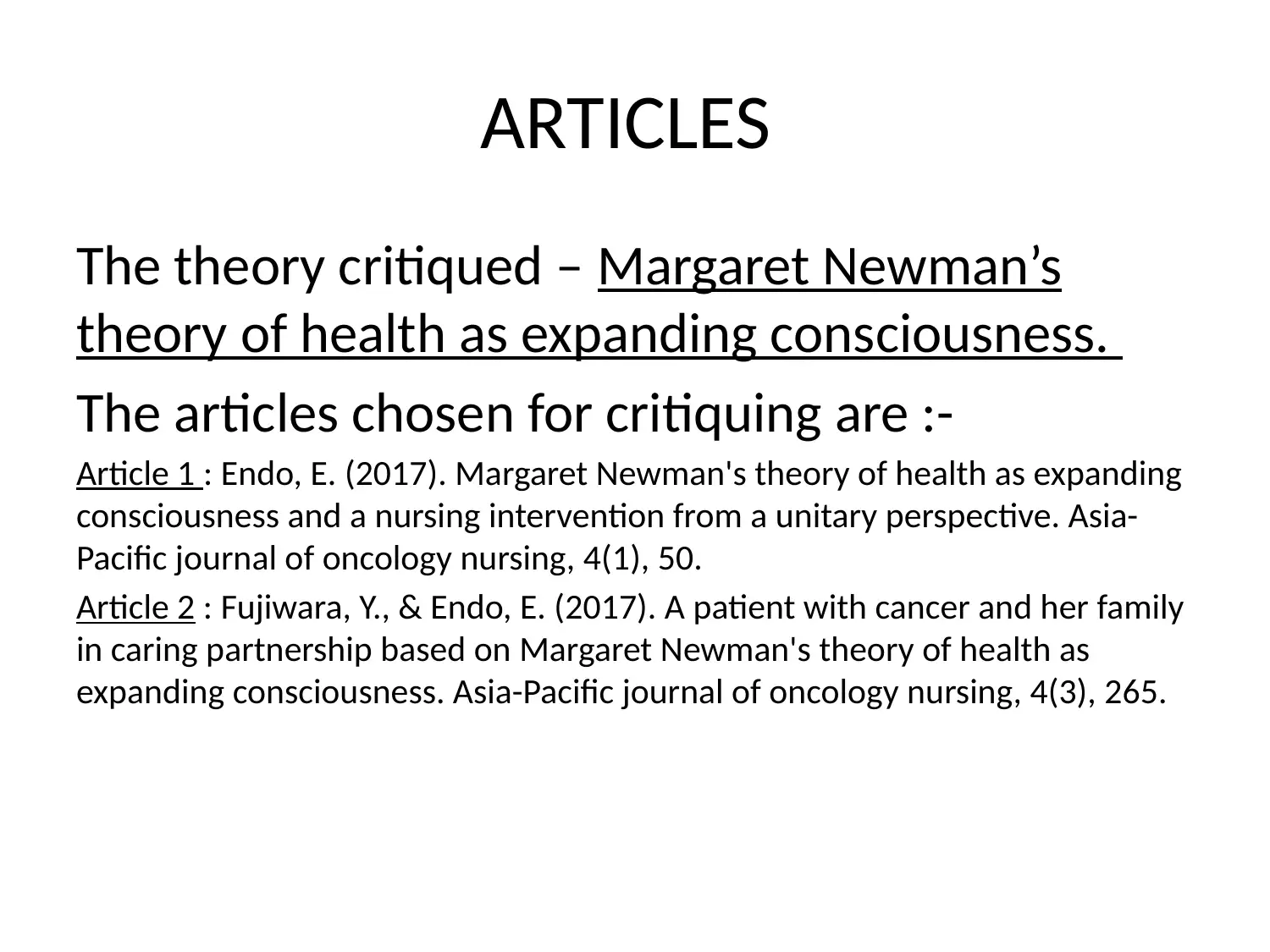
ARTICLES
The theory critiqued – Margaret Newman’s
theory of health as expanding consciousness.
The articles chosen for critiquing are :-
Article 1 : Endo, E. (2017). Margaret Newman's theory of health as expanding
consciousness and a nursing intervention from a unitary perspective. Asia-
Pacific journal of oncology nursing, 4(1), 50.
Article 2 : Fujiwara, Y., & Endo, E. (2017). A patient with cancer and her family
in caring partnership based on Margaret Newman's theory of health as
expanding consciousness. Asia-Pacific journal of oncology nursing, 4(3), 265.
The theory critiqued – Margaret Newman’s
theory of health as expanding consciousness.
The articles chosen for critiquing are :-
Article 1 : Endo, E. (2017). Margaret Newman's theory of health as expanding
consciousness and a nursing intervention from a unitary perspective. Asia-
Pacific journal of oncology nursing, 4(1), 50.
Article 2 : Fujiwara, Y., & Endo, E. (2017). A patient with cancer and her family
in caring partnership based on Margaret Newman's theory of health as
expanding consciousness. Asia-Pacific journal of oncology nursing, 4(3), 265.
Paraphrase This Document
Need a fresh take? Get an instant paraphrase of this document with our AI Paraphraser
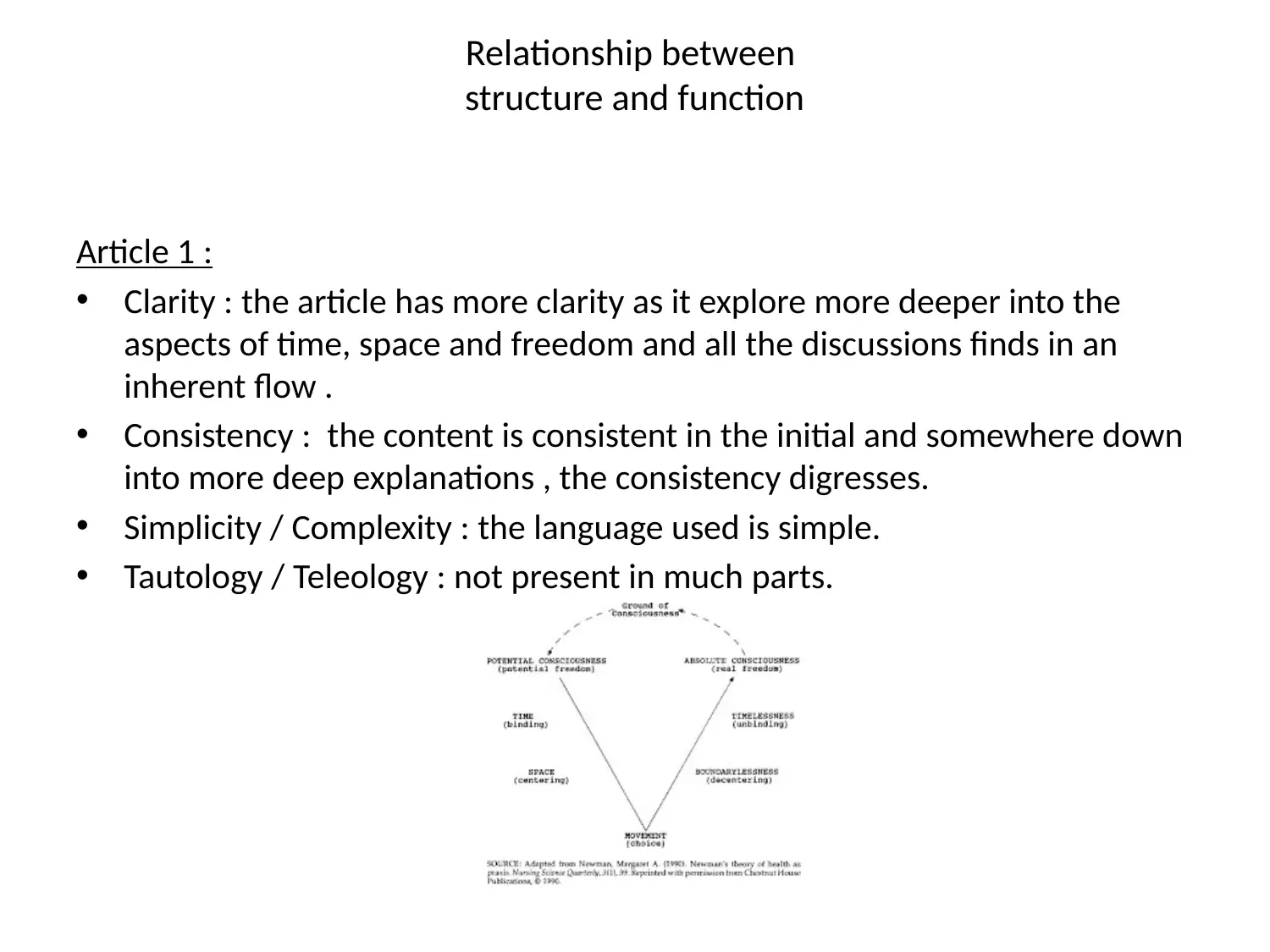
Relationship between
structure and function
Article 1 :
• Clarity : the article has more clarity as it explore more deeper into the
aspects of time, space and freedom and all the discussions finds in an
inherent flow .
• Consistency : the content is consistent in the initial and somewhere down
into more deep explanations , the consistency digresses.
• Simplicity / Complexity : the language used is simple.
• Tautology / Teleology : not present in much parts.
structure and function
Article 1 :
• Clarity : the article has more clarity as it explore more deeper into the
aspects of time, space and freedom and all the discussions finds in an
inherent flow .
• Consistency : the content is consistent in the initial and somewhere down
into more deep explanations , the consistency digresses.
• Simplicity / Complexity : the language used is simple.
• Tautology / Teleology : not present in much parts.
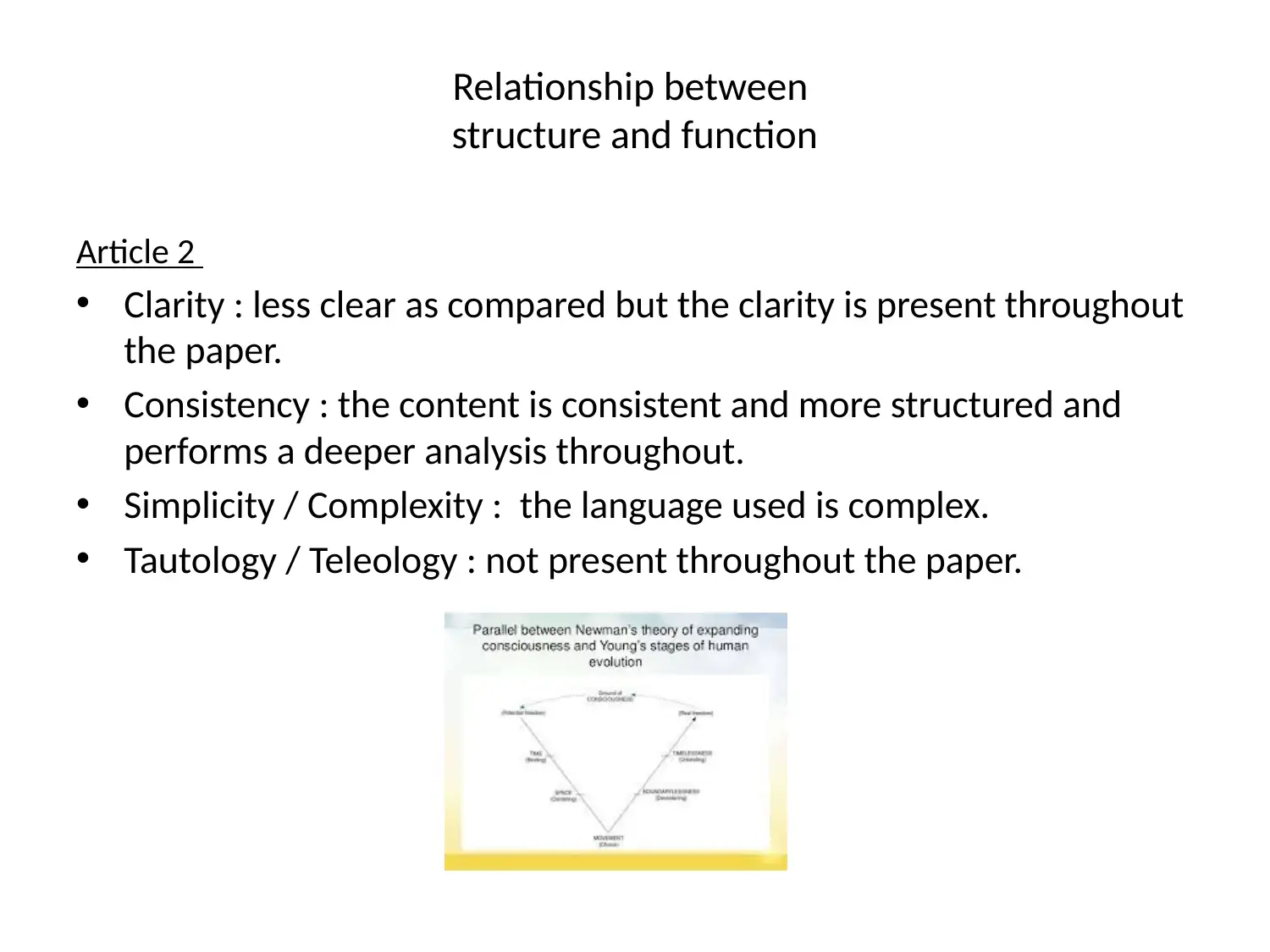
Relationship between
structure and function
Article 2
• Clarity : less clear as compared but the clarity is present throughout
the paper.
• Consistency : the content is consistent and more structured and
performs a deeper analysis throughout.
• Simplicity / Complexity : the language used is complex.
• Tautology / Teleology : not present throughout the paper.
structure and function
Article 2
• Clarity : less clear as compared but the clarity is present throughout
the paper.
• Consistency : the content is consistent and more structured and
performs a deeper analysis throughout.
• Simplicity / Complexity : the language used is complex.
• Tautology / Teleology : not present throughout the paper.
⊘ This is a preview!⊘
Do you want full access?
Subscribe today to unlock all pages.

Trusted by 1+ million students worldwide
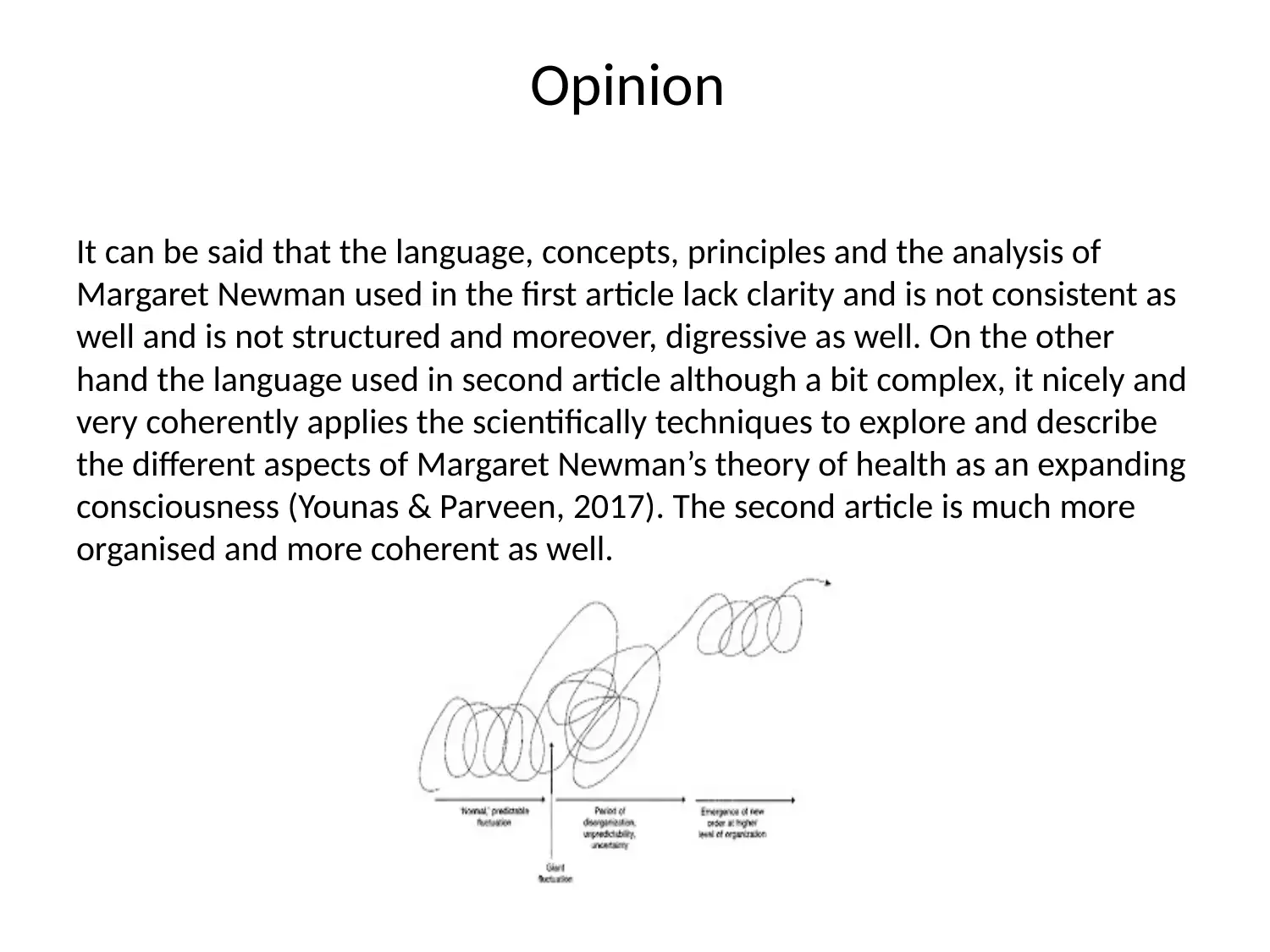
Opinion
It can be said that the language, concepts, principles and the analysis of
Margaret Newman used in the first article lack clarity and is not consistent as
well and is not structured and moreover, digressive as well. On the other
hand the language used in second article although a bit complex, it nicely and
very coherently applies the scientifically techniques to explore and describe
the different aspects of Margaret Newman’s theory of health as an expanding
consciousness (Younas & Parveen, 2017). The second article is much more
organised and more coherent as well.
It can be said that the language, concepts, principles and the analysis of
Margaret Newman used in the first article lack clarity and is not consistent as
well and is not structured and moreover, digressive as well. On the other
hand the language used in second article although a bit complex, it nicely and
very coherently applies the scientifically techniques to explore and describe
the different aspects of Margaret Newman’s theory of health as an expanding
consciousness (Younas & Parveen, 2017). The second article is much more
organised and more coherent as well.
Paraphrase This Document
Need a fresh take? Get an instant paraphrase of this document with our AI Paraphraser
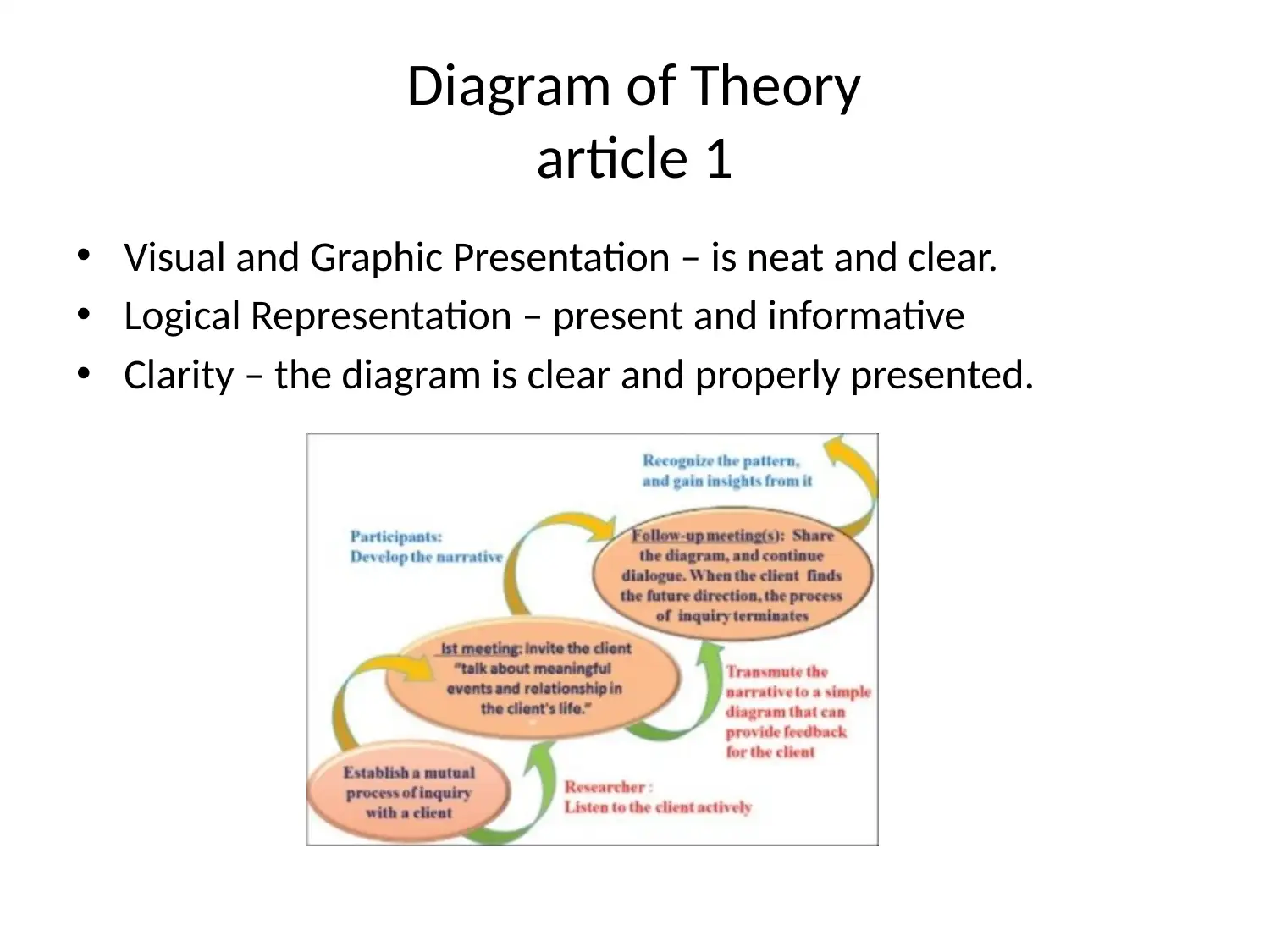
Diagram of Theory
article 1
• Visual and Graphic Presentation – is neat and clear.
• Logical Representation – present and informative
• Clarity – the diagram is clear and properly presented.
article 1
• Visual and Graphic Presentation – is neat and clear.
• Logical Representation – present and informative
• Clarity – the diagram is clear and properly presented.
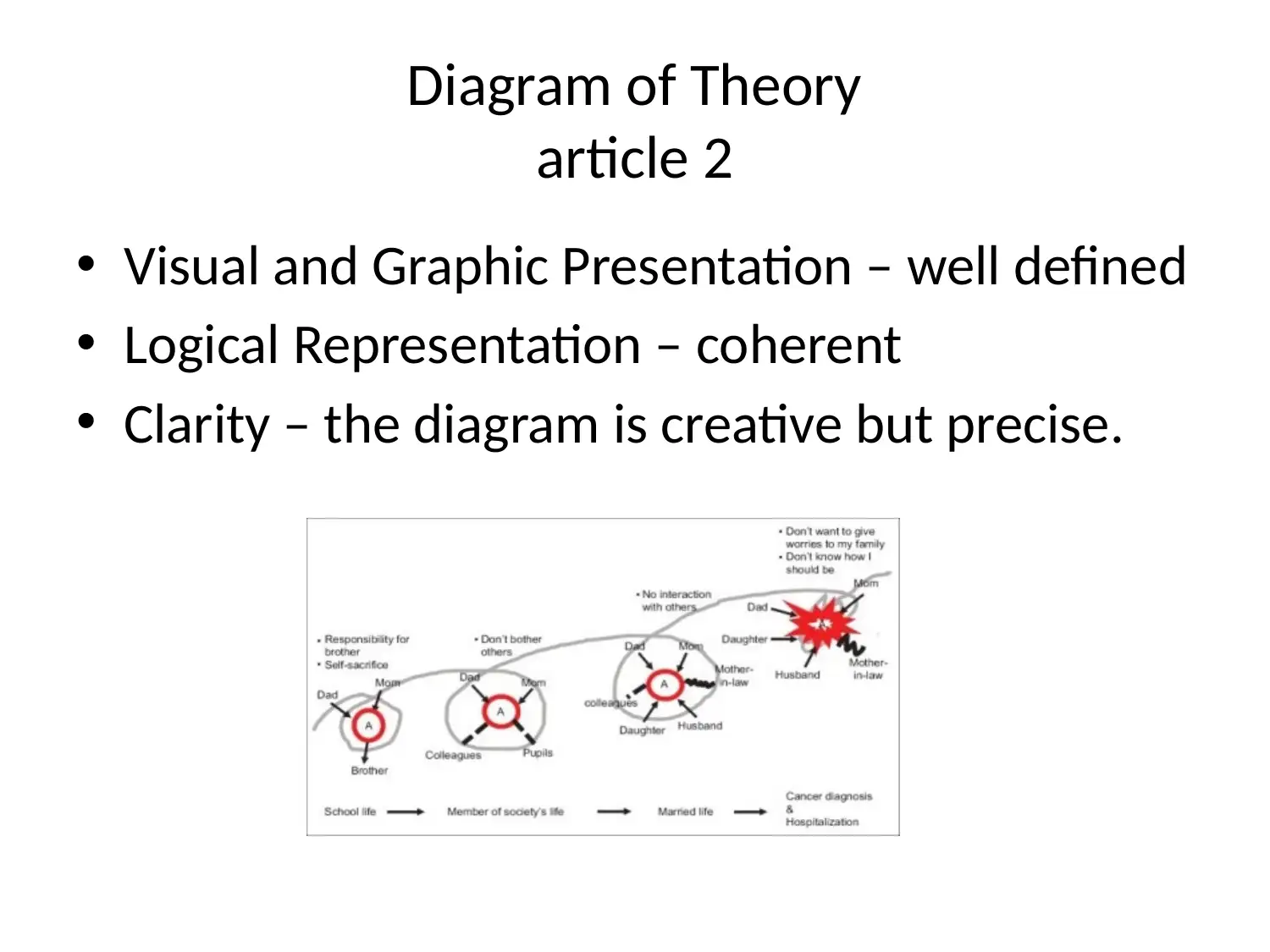
Diagram of Theory
article 2
• Visual and Graphic Presentation – well defined
• Logical Representation – coherent
• Clarity – the diagram is creative but precise.
article 2
• Visual and Graphic Presentation – well defined
• Logical Representation – coherent
• Clarity – the diagram is creative but precise.
⊘ This is a preview!⊘
Do you want full access?
Subscribe today to unlock all pages.

Trusted by 1+ million students worldwide
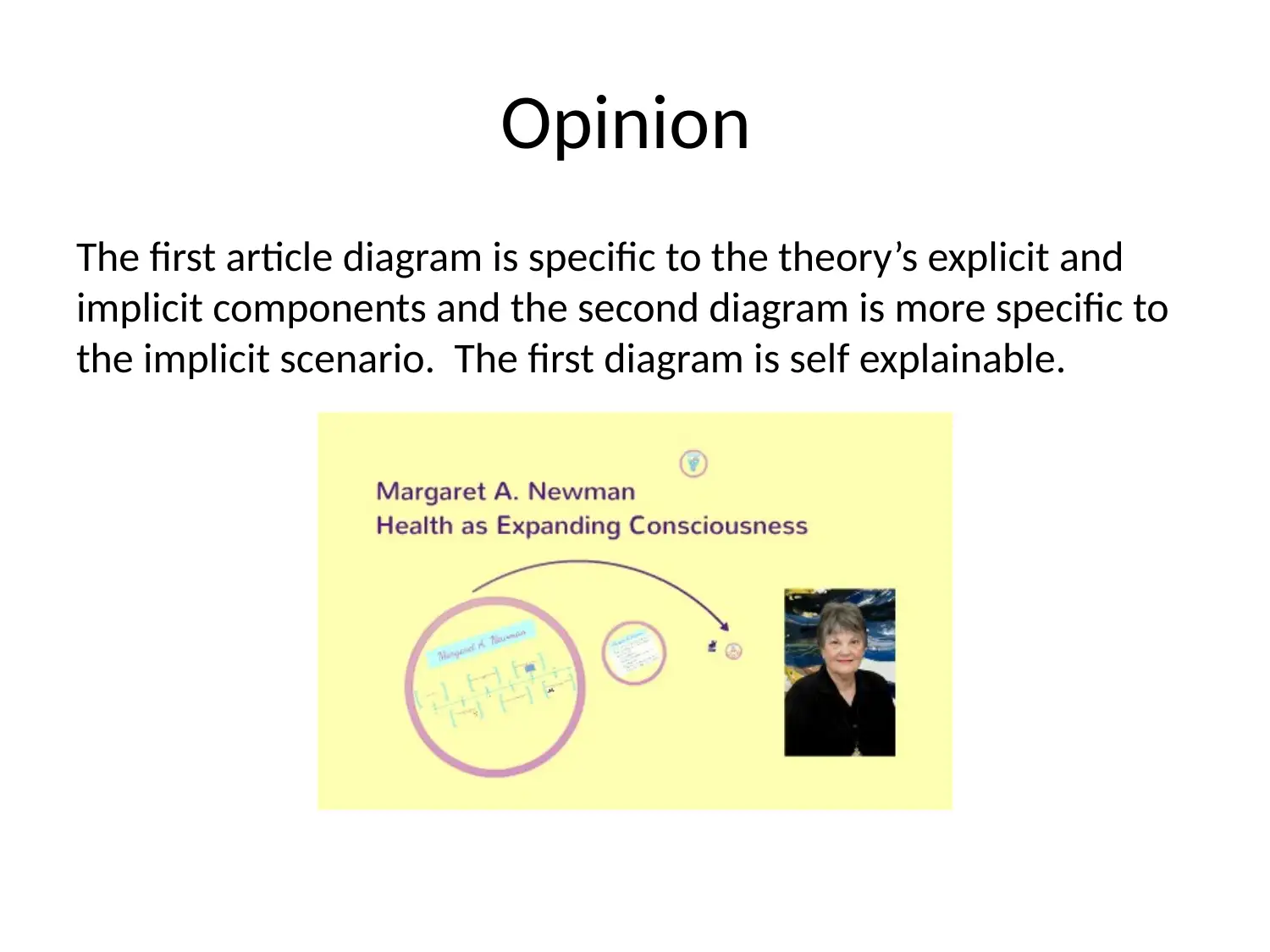
Opinion
The first article diagram is specific to the theory’s explicit and
implicit components and the second diagram is more specific to
the implicit scenario. The first diagram is self explainable.
The first article diagram is specific to the theory’s explicit and
implicit components and the second diagram is more specific to
the implicit scenario. The first diagram is self explainable.
Paraphrase This Document
Need a fresh take? Get an instant paraphrase of this document with our AI Paraphraser
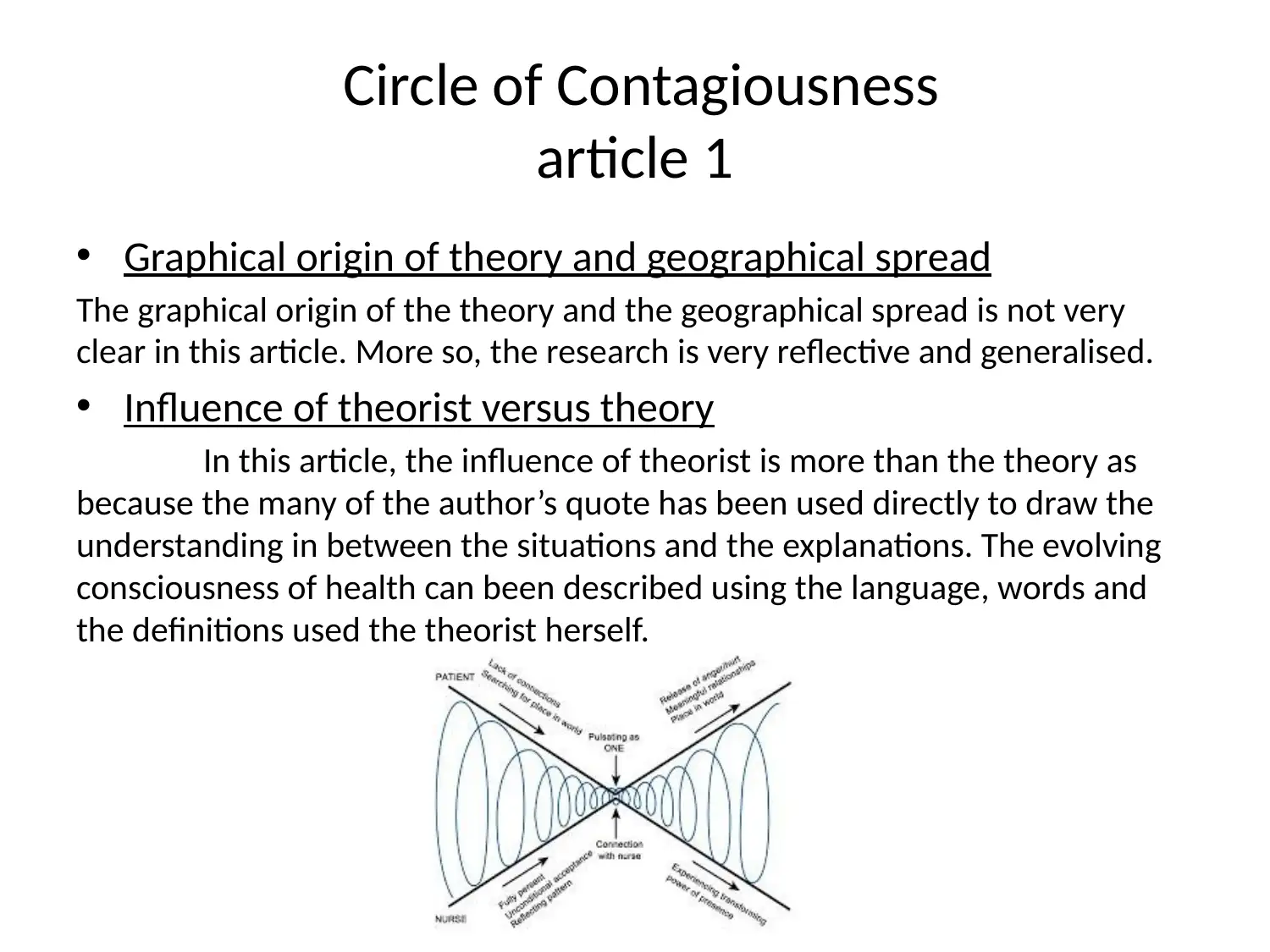
Circle of Contagiousness
article 1
• Graphical origin of theory and geographical spread
The graphical origin of the theory and the geographical spread is not very
clear in this article. More so, the research is very reflective and generalised.
• Influence of theorist versus theory
In this article, the influence of theorist is more than the theory as
because the many of the author’s quote has been used directly to draw the
understanding in between the situations and the explanations. The evolving
consciousness of health can been described using the language, words and
the definitions used the theorist herself.
article 1
• Graphical origin of theory and geographical spread
The graphical origin of the theory and the geographical spread is not very
clear in this article. More so, the research is very reflective and generalised.
• Influence of theorist versus theory
In this article, the influence of theorist is more than the theory as
because the many of the author’s quote has been used directly to draw the
understanding in between the situations and the explanations. The evolving
consciousness of health can been described using the language, words and
the definitions used the theorist herself.
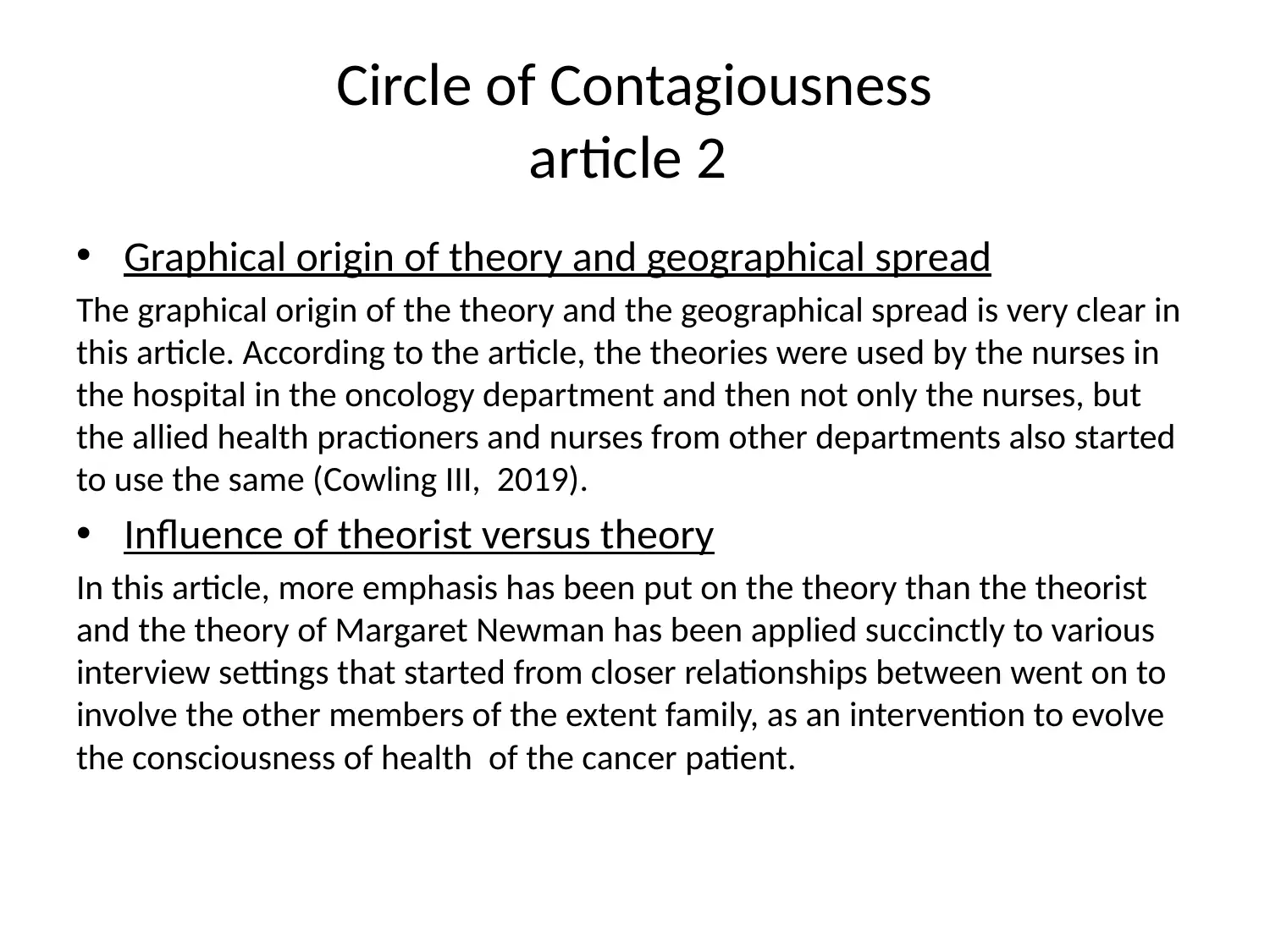
Circle of Contagiousness
article 2
• Graphical origin of theory and geographical spread
The graphical origin of the theory and the geographical spread is very clear in
this article. According to the article, the theories were used by the nurses in
the hospital in the oncology department and then not only the nurses, but
the allied health practioners and nurses from other departments also started
to use the same (Cowling III, 2019).
• Influence of theorist versus theory
In this article, more emphasis has been put on the theory than the theorist
and the theory of Margaret Newman has been applied succinctly to various
interview settings that started from closer relationships between went on to
involve the other members of the extent family, as an intervention to evolve
the consciousness of health of the cancer patient.
article 2
• Graphical origin of theory and geographical spread
The graphical origin of the theory and the geographical spread is very clear in
this article. According to the article, the theories were used by the nurses in
the hospital in the oncology department and then not only the nurses, but
the allied health practioners and nurses from other departments also started
to use the same (Cowling III, 2019).
• Influence of theorist versus theory
In this article, more emphasis has been put on the theory than the theorist
and the theory of Margaret Newman has been applied succinctly to various
interview settings that started from closer relationships between went on to
involve the other members of the extent family, as an intervention to evolve
the consciousness of health of the cancer patient.
⊘ This is a preview!⊘
Do you want full access?
Subscribe today to unlock all pages.

Trusted by 1+ million students worldwide
1 out of 20
Your All-in-One AI-Powered Toolkit for Academic Success.
+13062052269
info@desklib.com
Available 24*7 on WhatsApp / Email
![[object Object]](/_next/static/media/star-bottom.7253800d.svg)
Unlock your academic potential
Copyright © 2020–2025 A2Z Services. All Rights Reserved. Developed and managed by ZUCOL.